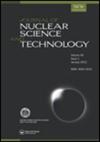利用MVP3和JENDL-5对热零功率条件下BEAVRS基准的全核分析
IF 1.7
4区 工程技术
Q2 NUCLEAR SCIENCE & TECHNOLOGY
引用次数: 0
摘要
摘要利用日本最新评估核数据库JENDL-5的发布,评估了JENDL-5对BEAVRS基准热零功率条件下中子参数的预测精度。计算了临界值、控制棒组值(CRW)、等温温度系数(ITC)和芯内探测器信号,并与实测数据进行了比较。对于临界,计算测量值(C/E)在1.0001和1.0045之间变化。用JENDL-5代替JENDL-4.0u1的截面数据进行敏感性分析,发现1H、235U、238U和16O对临界度有显著影响。个体CRW在50 pcm范围内一致,总CRW也在测量值的100 pcm范围内一致。与实测值相比,温度偏差为5.56 K的ITC计算结果被负高估;而在2.78 K条件下,测量值与实测值在一个标准偏差内一致。轴向检测器信号的最大相对误差为4.46%,均方根误差(RMSE)为2.13%。还研究了JENDL-4.0u1和JENDL-5之前版本之间的差异。免责声明作为对作者和研究人员的服务,我们提供了这个版本的已接受的手稿(AM)。在最终出版版本记录(VoR)之前,将对该手稿进行编辑、排版和审查。在制作和印前,可能会发现可能影响内容的错误,所有适用于期刊的法律免责声明也与这些版本有关。作者感谢JAEA的Kenichi Tada博士在处理FRENDY代码方面的支持,例如格式化的截面生成和绘图。图1所示。燃料组件(Asm.),可燃吸收器和控制棒组布局(四分之一旋转对称)[Citation28]。显示完整尺寸图2仪表管位置[引文28]。显示完整尺寸图3整个岩心在轴向中平面的水平面计算模型。显示完整尺寸图4。整个岩心的计算模型为岩心中心垂直平面。显示完整尺寸图5JENDL-4.0u1和JENDL-5在不同硼浓度和控制棒组条件下的临界性比较显示完整尺寸图6JENDL-4.0u1与JENDL-5在ARO (D = 213步)情况下的中子能谱比较。显示完整尺寸图7。JENDL-4.0u1与JENDL-5的核素取代反应性。显示完整尺寸图8。JENDL-4.0u1与JENDL-5水中1H TSL数据散射截面比较显示完整尺寸图9。JENDL-4.0u1与JENDL-5的16O捕获截面比较。显示完整尺寸图10JENDL-4.0u1和JENDL-5的235U裂变和俘获截面比较。显示完整尺寸图11。JENDL-4.0u1和JENDL-5的238U裂变和俘获截面比较。显示完整尺寸图12JENDL-4.0u1和JENDL-5对235U裂变和俘获反应速率的比较。显示完整尺寸图13JENDL-4.0u1和JENDL-5对238U裂变和俘获反应速率的比较显示完整尺寸图14。每个控制棒组的计算值与实测值之间的反应性差。显示完整尺寸图15。各控制棒组插入条件下的ITC计算值与实测值的比较。显示完整尺寸图16。轴向集成探测器信号JENDL-4.0u1计算结果与实测值的比较。显示完整尺寸图17JENDL-5轴向积分探测器信号计算结果与实测值的比较。显示完整尺寸图18。燃料组件8(原组件j8)中探测器信号轴向分布计算结果与实测值的比较。显示完整尺寸图19。燃料组件e13(原组件c5)中探测器信号轴向分布计算结果与实测值的比较。显示完整尺寸。控制棒组值计算结果与实测数据的比较。下载CSVDisplay table表7。ITC计算结果与实测数据的比较。下载CSVDisplay table表8。JENDL-4.0u1和JENDL-5在控制棒组C和D插入情况下ITC、MTC和FTC的比较。下载csv显示表本文章由计算机程序翻译,如有差异,请以英文原文为准。
Whole core analysis of BEAVRS benchmark for hot zero Power condition using MVP3 with JENDL-5
ABSTRACTWith the release of the latest Japanese evaluated nuclear data library JENDL-5, the prediction accuracy of JENDL-5 for neutronics parameters of the BEAVRS benchmark for the hot zero power condition was evaluated in this study. The criticality, control rod bank worth (CRW), isothermal temperature coefficient (ITC), and in-core detector signals were calculated and compared with the measured data for evaluation. For the criticality, the calculation-to-measurement (C/E) values varied between 1.0001 and 1.0045. Sensitivity analysis by replacing cross section data from the JENDL-4.0u1 with JENDL-5 revealed that 1H, 235U, 238U, and 16O significantly affected the criticality. The individual CRW agreed within 50 pcm, and total CRW also agreed within 100 pcm from the measured values. The ITC results calculated with a temperature deviation of 5.56 K case were negatively overestimated comparing with the measured values; whereas those of with 2.78 K were improved and agreed with the measured values within a standard deviation. The axial detector signals indicated a maximum relative error of 4.46% and the root mean squared error (RMSE) of 2.13%. The differences between the previous version of JENDL-4.0u1 and JENDL-5 were also investigated.DisclaimerAs a service to authors and researchers we are providing this version of an accepted manuscript (AM). Copyediting, typesetting, and review of the resulting proofs will be undertaken on this manuscript before final publication of the Version of Record (VoR). During production and pre-press, errors may be discovered which could affect the content, and all legal disclaimers that apply to the journal relate to these versions also. AcknowledgementsThe authors thank Dr. Kenichi Tada of JAEA for the support in the handling FRENDY code, such as formatted cross section generation and plotting.Figure 1. Fuel assembly (Asm.), burnable absorber, and control rod bank layout (quarter rotational symmetry) [Citation28].Display full sizeFigure 2. Instrument tube positions [Citation28].Display full sizeFigure 3. Whole core calculation model of the horizontal plane at the axial mid-plane.Display full sizeFigure 4. Whole core calculation model of the vertical plane at the core center.Display full sizeFigure 5. Comparison of criticality between JENDL-4.0u1 and JENDL-5 for six cases with different boron concentrations and control rod bank conditions.Display full sizeFigure 6. Comparison of neutron spectra between JENDL-4.0u1 and JENDL-5 in ARO (D = 213 steps) case.Display full sizeFigure 7. Nuclide Substitution Reactivity of JENDL-4.0u1 with JENDL-5.Display full sizeFigure 8. Comparison of scattering cross sections of TSL data for 1H in H2O between JENDL-4.0u1 and JENDL-5.Display full sizeFigure 9. Comparison of capture cross sections of 16O between JENDL-4.0u1 and JENDL-5.Display full sizeFigure 10. Comparison of fission and capture cross sections of 235U between JENDL-4.0u1 and JENDL-5.Display full sizeFigure 11. Comparison of fission and capture cross sections of 238U between JENDL-4.0u1 and JENDL-5.Display full sizeFigure 12. Comparison of fission and capture reaction rates of 235U between JENDL-4.0u1 and JENDL-5.Display full sizeFigure 13. Comparison of fission and capture reaction rates of 238U between JENDL-4.0u1 and JENDL-5.Display full sizeFigure 14. Reactivity difference between the calculated and measured values for each control rod bank.Display full sizeFigure 15. Comparison of ITC between calculated and measured values for each control rod bank insertion condition.Display full sizeFigure 16. Comparison of axially integrated detector signals between the calculated results of JENDL-4.0u1 and measured values.Display full sizeFigure 17. Comparison of axially integrated detector signals between the calculated results of JENDL-5 and measured values.Display full sizeFigure 18. Comparison of detector signal axial distribution between the calculated results and measured values in fuel assembly g8 (original assembly j8).Display full sizeFigure 19. Comparison of detector signal axial distribution between the calculated results and measured values in fuel assembly e13 (original assembly c5).Display full sizeTable 6. Comparison of control rod bank worth between calculation results and measurement data.Download CSVDisplay TableTable 7. Comparison of ITC between calculation results and measurement data.Download CSVDisplay TableTable 8. Comparison of ITC, MTC, and FTC of JENDL-4.0u1 and JENDL-5 in control rod bank C and D insertion case.Download CSVDisplay Table
求助全文
通过发布文献求助,成功后即可免费获取论文全文。
去求助
来源期刊

Journal of Nuclear Science and Technology
工程技术-核科学技术
CiteScore
2.40
自引率
16.70%
发文量
116
审稿时长
2.3 months
期刊介绍:
The Journal of Nuclear Science and Technology (JNST) publishes internationally peer-reviewed papers that contribute to the exchange of research, ideas and developments in the field of nuclear science and technology, to contribute peaceful and sustainable development of the World.
JNST ’s broad scope covers a wide range of topics within its subject category, including but are not limited to:
General Issues related to Nuclear Power Utilization: Philosophy and Ethics, Justice and Policy, International Relation, Economical and Sociological Aspects, Environmental Aspects, Education, Documentation and Database, Nuclear Non-Proliferation, Safeguard
Radiation, Accelerator and Beam Technologies: Nuclear Physics, Nuclear Reaction for Engineering, Nuclear Data Measurement and Evaluation, Integral Verification/Validation and Benchmark on Nuclear Data, Radiation Behaviors and Shielding, Radiation Physics, Radiation Detection and Measurement, Accelerator and Beam Technology, Synchrotron Radiation, Medical Reactor and Accelerator, Neutron Source, Neutron Technology
Nuclear Reactor Physics: Reactor Physics Experiments, Reactor Neutronics Design and Evaluation, Reactor Analysis, Neutron Transport Calculation, Reactor Dynamics Experiment, Nuclear Criticality Safety, Fuel Burnup and Nuclear Transmutation,
Reactor Instrumentation and Control, Human-Machine System: Reactor Instrumentation and Control System, Human Factor, Control Room and Operator Interface Design, Remote Control, Robotics, Image Processing
Thermal Hydraulics: Thermal Hydraulic Experiment and Analysis, Thermal Hydraulic Design, Thermal Hydraulics of Single/Two/Multi Phase Flow, Interactive Phenomena with Fluid, Measurement Technology...etc.
 求助内容:
求助内容: 应助结果提醒方式:
应助结果提醒方式:


